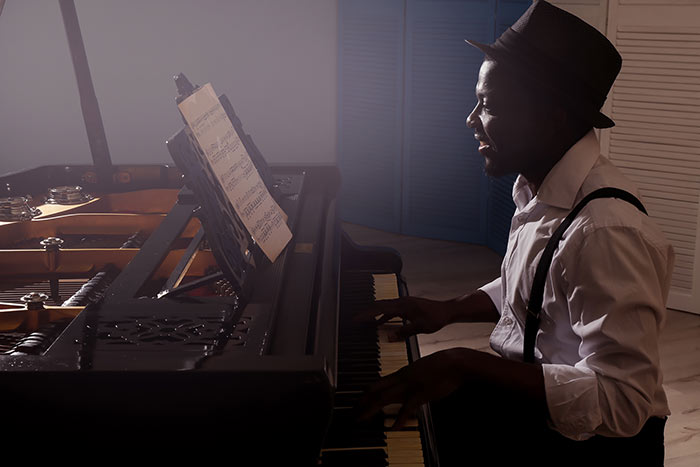For most non-jazz musicians and beginners, the assumption is that jazz improvisation is conjured out of thin air, and that improvised phrases are a stream of consciousness. The truth is that jazz musicians are discerning magpies, who always have an ear open to catch a phrase played by another musician, with the intention of using it in their own improvisations.
Learning to play jazz is, to me, exactly like learning to speak a foreign language fluently. When learning to speak a language we are usually given stock phrases to use that can be altered to suit different situations. In the exact same way, in jazz we learn “licks” – short musical phrases that act as building blocks for improvisation.
The universal library of licks, after over 100 years of evolution, is now too large for anyone to memorise in full. This grants the modern jazz musician a powerful gift: the opportunity to hand-pick and transcribe the best licks recorded by musicians in every corner of jazz, to form the basis of their improvisational signature.
Licks are most useful at the end of a harmonic sequence, where in functional harmony you will often find a Perfect Cadence (chords II-V-I). The transition from chord V to chord I is the most common in jazz, and so learning licks that can be played over this cadence will help you cover a lot of ground. A good jazz lick should do at least one of the following: describe the harmonic movement, and have a strong melodic shape. With this rule in mind, here are five II-V-I licks for the piano that I think everyone should know.
1. Arpeggio Up, Scale Down
This lick should be one of the first that a jazz musician learns. It covers the four strong notes of Dm7 in an arpeggio (broken chord) ascending, and then runs down the scale for G7, ending on the strong chord tone of E (the 3rd note of C major). This lick is simple, but effective, and leaves the door wide open for manipulation and evolution. Try playing this lick up a 3rd for example!
2. Arpeggios Down and Up
When practising improvisation, a good technique for getting your fingers around a chord sequence is to practise running up and down the arpeggios for each chord. In this example, you run down the Dm7 arpeggio, and then up the G7 arpeggio. For added melodic movement, this lick adds an Ab, giving you a strong chromatic movement from the start of the lick to the end. This is a concept you can use over entire chord sequences in a lot of jazz standards, so going over the chord changes slowly playing this lick will help get it all under your fingers.
3. Descending Scales
An important part of making a strong melodic shape is landing on a strong note in the right place. This can be difficult when running up and down scales, as you can be forced into landing on a weak note. To fix this, you can add a chromatic passing note into your line (look up bebop scales, revolutionised by Charlie Parker), or in this example, jump back up the scale and alter it. Bill Evans was a master at this technique of using chromaticism to get to his target note, so be sure to listen to his records.
4. Altered Triad Pairs
This lick is all about strong melodic shape, and very little to do with the harmony! Here we ignore the Dm7, focussing entirely on the G7 and using the Altered scale (also known as Ab melodic minor). Within this scale you can find the triads of Eb and Db major. Playing these back-to-back and ending on C gives you very strong melodic shapes, achieving a more modern sounding lick. Delaying the end of the phrase and ending on a Bb (flat 7) also adds to this effect. This example is quite different to the others, and to make it work in the context of a whole solo there is a whole world of language in Melodic Minor harmony that you will want to learn over time. The Altered scale is a good start! To play this, take your chord (G7), go up a semitone and play the Melodic Minor scale (Abm).
5. Arpeggio Down, Double Altered Enclosure
The arpeggio, as mentioned previously, is a strong melodic shape to have in a lick. Another strong melodic shape is what we call an enclosure, where you precede your final note with the notes either side of it. In this case, I’ve doubled down on it, with two enclosures! This lick combines clear harmonic description with strong melodic shape.
These five licks vary in difficulty, and the first step to mastering them is to play them in every key slowly. This allows you to absorb the sound of each lick, and apply it in every situation you might want to use it.
I also recommend not neglecting your left hand in this exercise, so always practise playing either the bass note or chords in the left hand so you don’t lose track of the harmony. These licks are all open to be developed by you, just like the great jazz musicians of the last 100 years have developed the licks of their predecessors and made them their own.
Always remember that playing a lick on its own will not be enough to make it an effective solo phrase, licks are just the building blocks, so use slow practise to work them into your solos and build around them, and above all be patient with the process!












